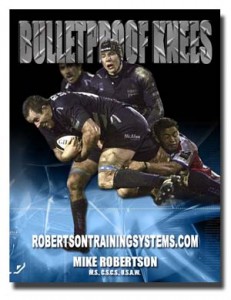Part 3 of the return to normal in-season hockey training following knee surgery…
If you missed the first two posts, check them out below:
Training Hockey Players with Knee Injuries
Hockey Training with a Knee Injury
Following the first 4 weeks of training (described in the previous two posts), the player visited Shattuck St. Mary’s so he missed a week of training. When he returned, he said he’d been doing loaded, full range of motion exercises on both legs at physical therapy. His brace had been removed and he was cleared to do normal full range of motion movements, just not jump or sprint work.
I was told he had two more weeks of physical therapy, then he’d probably need another month before he’s able to return to full speed running, cutting, jumping, and skating.
Phase 3 (Weeks 5-7): Upper Body/Non-Operative Leg (Heavy)/Operative Leg (Light)
Program Goals:
- Improve upper body strength and power
- Improve core strength and power
- Improve strength/coordination of the non-operative leg/hip
- Improve single-leg stability on operative knee while minimizing compression
- Make him work hard so he still “feels” like an athlete
- Use exercises that won’t piss off PT or surgeon
A sample training session would look like:
A1) 1-Leg Squat: 4 x 12/side
A2) DB Incline Chest Press: 3 x 8
A3) 4-Way Stability Ball Front Plank: 3 x (3×4)/side
A4) Scap Wall Slide: 3 x 8
B1) 1-Arm DB Row: 3 x 8/side
B2) Split Squat (Front foot on BOSU): 3 x 8/side
B3) Rice Digs: 3 x 60s
C) Lying Partner Multi-Planar Hamstring Stretch
The major changes in this program were the addition of single-leg exercises (A1 and B2) performed on BOTH legs. He told me his balance was terrible since the injury, which is why I went with higher reps on the 1-leg squats and added the BOSU for the spit squats. He really struggled with these at first, but made a ton of progress from set to set.
Multi-planar hamstring stretch
Lastly, this player has great range of motion everywhere except in his hamstrings, so we added a long hamstring stretch emphasizing hip flexion in a neutral rotation position, in external rotation and abduction (leg going outside of hip), and in internal rotation and adduction (leg going toward opposite shoulder).
I’ve had success training hockey players with knee injuries, both in terms of improving their strength/performance and minimizing/preventing knee pain or further injury. A lot of what I know about preventing and training around knee injuries I learned from my colleague Mike Robertson. He put together an incredible resource, Bulletproof Knees, that I HIGHLY recommend to anyone with a history of knee pain/injury or currently dealing with knee pain. Bulletproof Knees details exactly how you can figure out what’s wrong with you (it may not be a knee problem causing your knee pain!) and gives you the exercises to fix it. Check it out below:
-Kevin Neeld


